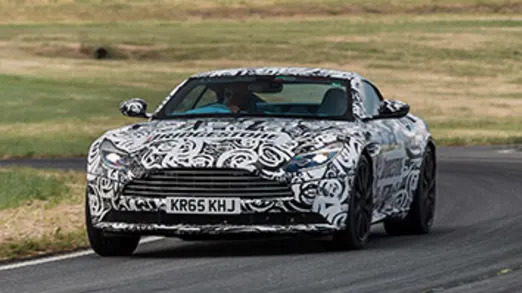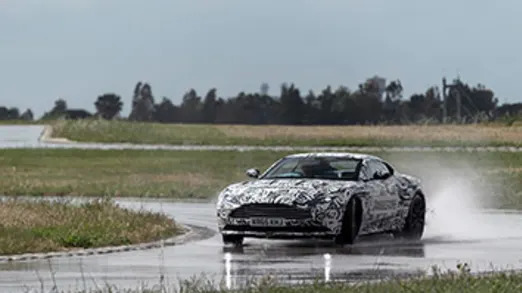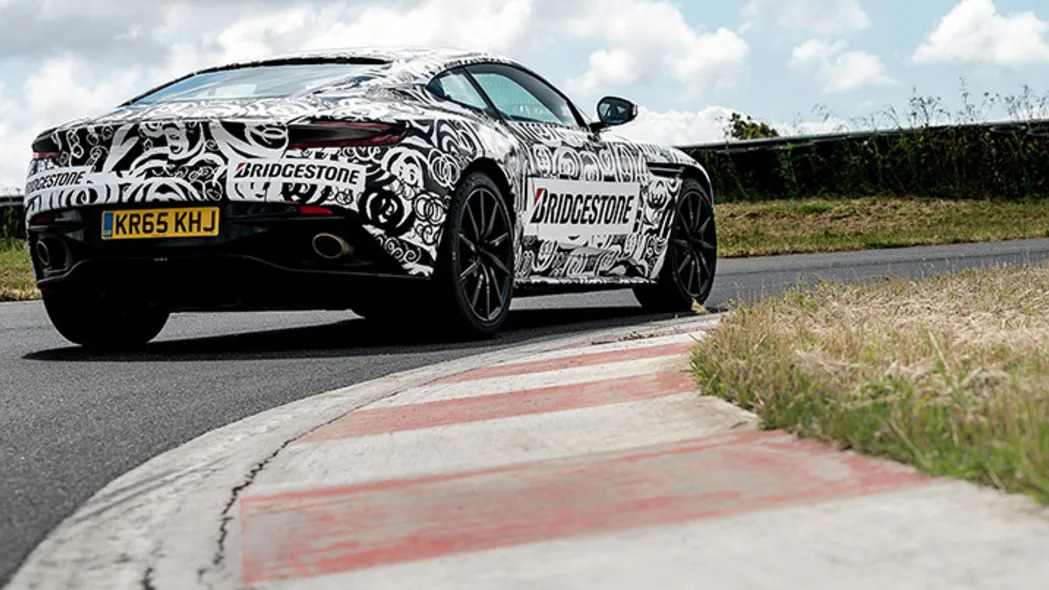-
EngineTwin-Turbo 5.2L V12
-
Power600 HP / 516 LB-FT
-
Transmission8-Speed Auto
-
0-60 Time5.1 Sec
-
Top Speed200 MPH
-
DrivetrainRear-Wheel Drive
-
Seating2+2
-
Base Price$211,995
Flashback: Geneva. The 2017 Aston Martin DB11 debuts, its artfully sculpted body signaling a departure from the brand's luscious yet familiar design language. But this time, the car in question is more than just a pretty face. Beneath the gently arced bonnet is the first turbocharged engine in the Aston's 103 year-old history. Gone is the so-called Vertical Horizontal architecture, replaced with a bonded aluminum chassis that's so new that it has yet to be graced with a catchy marketing name.
Sumptuous interior? Check. Slick multimedia system? Finally. The quickest, fastest, and most powerful DB to date? Hell yes. With radical changes coming in hot from Gaydon, the DB11 isn't just an all-new car; it's nothing short of golden opportunity to reinvent the brand.



There's so much new stuff in this DB9 replacement that the double integer leap in nomenclature seems justified (the DB10 was already taken by a certain spy from Blighty). In the grand scope of the Aston Martin lineup, the DB11 inherits the DB9's role as the archetypal grand touring car—elegant but quick, thirsty for miles. But as our wheel time revealed, it takes some time to comprehend the depth of the DB11 story.
When you settle into the $211,995 Aston Martin DB11 there's a lot to take in, especially since our tester is a "verification prototype" that's two stages away from final production. Hence, the data logging equipment and big red fire suppression button. The engine has shrunk from 6.0-liters to 5.2, but now churns out 600 horsepower and a whopping 516 lb-ft of torque at only 1,500 rpm thanks to those turbos. Aston claims 0 to 62 mph in 3.9 seconds and a top speed of 200 mph. The rear double wishbone suspension has been replaced with a multilink setup for greater compliance, and the DB11 also gets Aston's first-ever torque vectoring (via brakes) and electronic power steering system.
The prototype car is a visual paradox, with its camouflaged exterior contrasting with the delightfully gaudy baby blue leather interior (made from extra trimmings of hide). In terms of development, the car is about "85 percent there" according to Aston brass. Disclaimer: this car's traction control system is only about 70 percent complete, and the torque-vectoring feature isn't active on this particular car.




The big V12 fires up with a full-sounding rush of exhaust, though the tone isn't quite as naughty or shrill as the old naturally aspirated mill. But luxury fiends may actually delight in the reduced decibels, not to mention the fact that the production car will have a "quiet start" feature that produces even shhhhhh-ier startups.



Shift the transaxle-mounted ZF 8-speed transmission into first (by tapping the paddle or pressing the "D" on the dash), touch the gas, and the DB11 feels mighty and alive. There may be incrementally less throttle response at low rpms compared to the DB9, but apart from the window sticker it's all but impossible to tell the DB11 is a turbo until the higher rpms. Power is available almost immediately and accumulates linearly until it peaks at 6,500 rpm. The tapering off at the last few thousand rpm is the big hint that the engine utilizes forced induction (unlike hard charging mills in more aggressively tuned sleds from McLaren and Porsche). Acceleration is intense, especially towards the middle of the rev range, and the transmission shifts quickly and smoothly enough to discourage any suggestion of dual-clutch alternatives.
Engine and transmission responsiveness can be set to GT, Sport, or Sport Plus via a steering wheel-mounted button. A progression through the modes reveals intrusive intervention in the first two modes, and a bit more wiggle room in Sport Plus, which allows for a decent about of slip angle before the computers catch what you're up to.
Without conceding too much to comfort and softness, the DB11's ride on Bridgestone's dry handling course is impressively composed and controlled, showing taught handling without any overly abusive damping characteristics. While the default setting allows for some noticeable body roll, a steering wheel-mounted button tightens the valves on the Bilstein dampers, allowing for less roll and greater attack. On tight corners with all systems off, the DB11 seemed to grow in size, understeering a bit before the tail came around and slid it through the corner. We expect the production version's torque vectoring and understeer mitigation system to reduce, if not eliminate, that tendency.

Within the Aston Martin microcosm, the DB11 is a revolution that has the power to expand the brand's potential on an exponential level. Quick, composed, and compelling, the DB11 straddles the lines of comfort and speed and easily achieves the qualities that it a world-class grand touring coupe.
Its driving dynamics and styling are such seismic improvements that they have the power to transform Aston Martin from a scrappy competitor clinging to old platforms and aging technology, to a force to be reckoned with. The new chassis feels agile and capable; the engine – though not as acoustically stirring as its naturally aspirated ancestor – hauls ass; the interior is sumptuous and imaginative; and, the Daimler-sourced infotainment system has finally entered the 21 st century.
The DB11 ticks a lot of crucial boxes, and represents a significant accomplishment. If the verification prototype is any indication, the DB11 just might be the first Aston Martin in years to offer a thoroughly modern and viable alternative to stalwarts like Bentley and Rolls-Royce.
Related Video:

Sumptuous interior? Check. Slick multimedia system? Finally. The quickest, fastest, and most powerful DB to date? Hell yes. With radical changes coming in hot from Gaydon, the DB11 isn't just an all-new car; it's nothing short of golden opportunity to reinvent the brand.



There's so much new stuff in this DB9 replacement that the double integer leap in nomenclature seems justified (the DB10 was already taken by a certain spy from Blighty). In the grand scope of the Aston Martin lineup, the DB11 inherits the DB9's role as the archetypal grand touring car—elegant but quick, thirsty for miles. But as our wheel time revealed, it takes some time to comprehend the depth of the DB11 story.
When you settle into the $211,995 Aston Martin DB11 there's a lot to take in, especially since our tester is a "verification prototype" that's two stages away from final production. Hence, the data logging equipment and big red fire suppression button. The engine has shrunk from 6.0-liters to 5.2, but now churns out 600 horsepower and a whopping 516 lb-ft of torque at only 1,500 rpm thanks to those turbos. Aston claims 0 to 62 mph in 3.9 seconds and a top speed of 200 mph. The rear double wishbone suspension has been replaced with a multilink setup for greater compliance, and the DB11 also gets Aston's first-ever torque vectoring (via brakes) and electronic power steering system.
The prototype car is a visual paradox, with its camouflaged exterior contrasting with the delightfully gaudy baby blue leather interior (made from extra trimmings of hide). In terms of development, the car is about "85 percent there" according to Aston brass. Disclaimer: this car's traction control system is only about 70 percent complete, and the torque-vectoring feature isn't active on this particular car.




The big V12 fires up with a full-sounding rush of exhaust, though the tone isn't quite as naughty or shrill as the old naturally aspirated mill. But luxury fiends may actually delight in the reduced decibels, not to mention the fact that the production car will have a "quiet start" feature that produces even shhhhhh-ier startups.
The turbocharged powerplant was influenced by the pressure to conform to fuel economy and emissions requirements. But the upside is greater energy density and a fatter torque curve. How's the sound? Well, that topic is a bit more subjective. If you like your engine raucous, you'll most certainly miss aspects of the old motor. Though the turbo V12 is a tad hushed (it doesn't use any artificial enhancements to boost the cabin experience), the jury's is still out: the final exhaust tune might sound slightly different than the prototype.If you like your engine raucous, you'll most certainly miss aspects of the old motor.



Shift the transaxle-mounted ZF 8-speed transmission into first (by tapping the paddle or pressing the "D" on the dash), touch the gas, and the DB11 feels mighty and alive. There may be incrementally less throttle response at low rpms compared to the DB9, but apart from the window sticker it's all but impossible to tell the DB11 is a turbo until the higher rpms. Power is available almost immediately and accumulates linearly until it peaks at 6,500 rpm. The tapering off at the last few thousand rpm is the big hint that the engine utilizes forced induction (unlike hard charging mills in more aggressively tuned sleds from McLaren and Porsche). Acceleration is intense, especially towards the middle of the rev range, and the transmission shifts quickly and smoothly enough to discourage any suggestion of dual-clutch alternatives.
Engine and transmission responsiveness can be set to GT, Sport, or Sport Plus via a steering wheel-mounted button. A progression through the modes reveals intrusive intervention in the first two modes, and a bit more wiggle room in Sport Plus, which allows for a decent about of slip angle before the computers catch what you're up to.
Without conceding too much to comfort and softness, the DB11's ride on Bridgestone's dry handling course is impressively composed and controlled, showing taught handling without any overly abusive damping characteristics. While the default setting allows for some noticeable body roll, a steering wheel-mounted button tightens the valves on the Bilstein dampers, allowing for less roll and greater attack. On tight corners with all systems off, the DB11 seemed to grow in size, understeering a bit before the tail came around and slid it through the corner. We expect the production version's torque vectoring and understeer mitigation system to reduce, if not eliminate, that tendency.

Within the Aston Martin microcosm, the DB11 is a revolution that has the power to expand the brand's potential on an exponential level. Quick, composed, and compelling, the DB11 straddles the lines of comfort and speed and easily achieves the qualities that it a world-class grand touring coupe.
Its driving dynamics and styling are such seismic improvements that they have the power to transform Aston Martin from a scrappy competitor clinging to old platforms and aging technology, to a force to be reckoned with. The new chassis feels agile and capable; the engine – though not as acoustically stirring as its naturally aspirated ancestor – hauls ass; the interior is sumptuous and imaginative; and, the Daimler-sourced infotainment system has finally entered the 21 st century.
The DB11 ticks a lot of crucial boxes, and represents a significant accomplishment. If the verification prototype is any indication, the DB11 just might be the first Aston Martin in years to offer a thoroughly modern and viable alternative to stalwarts like Bentley and Rolls-Royce.
Related Video:











Sign in to post
Please sign in to leave a comment.
Continue